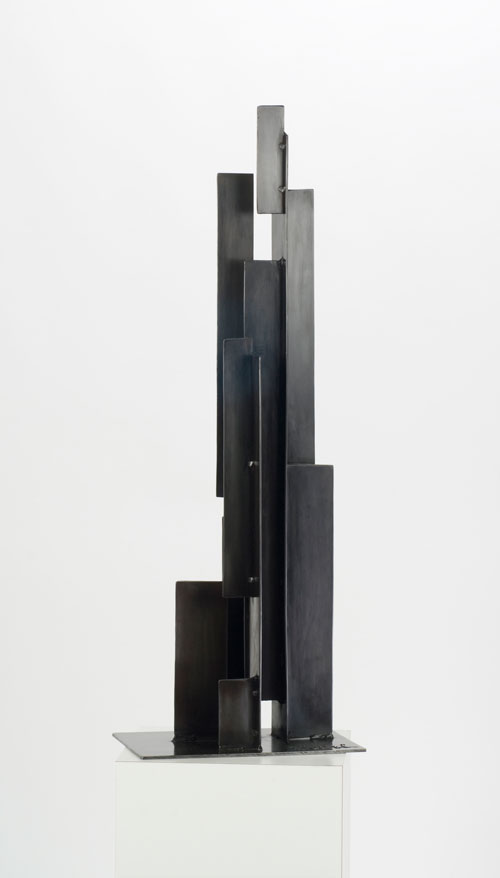The exhibition of Dennis Leri's work at Ashawagh Hall in Springs begs the question yet again of what constitutes true minimalist art. With the ascendance of minimalism in sculpture in the 1960s, the general assumption was always that reductive principles dictated that artists were required to follow distinctive criteria in order to be considered actual "minimalists."
These criteria included the dismissal of overt representation, the avoidance of allegorical associations, and the silencing of any suggestion of transcendent spirituality within the artwork.
Demanding a dispassionately cool anonymity at the expense of the feverishly assertive personal components that had been the hallmarks of abstract expressionism, minimalism’s adherents asserted that the meaning of an artistic entity resided not within, but rather solely on its surface.
Further, they maintained that aesthetics were secondary to the artist’s responsibility for making socio/ideological statements about the nature of art itself and, in addition, that the intellectual presence of the artist was completely destructive to the message being conveyed. In essence, picture a row of unpainted boxes and there's a good chance you're looking at a minimalist masterpiece.
As time passed, though, artists and sculptors such as Dennis Leri have come to recognize that the import and application of minimalist principles need not be limited by the doctrinaire rigidity espoused by its initial practitioners. Instead, these artists have acknowledged that it is possible to expose the essence of a subject through the elimination of all non-essential images, forms or ideas without removing the aesthetic concept of composition nor eradicating the intellectual aura of the artist himself.
This is particularly apparent in Leri’s current exhibition at Ashawagh Hall. "Convergence" features sculptures and wall pieces that illustrate a masterful stripping away of any redundantly excessive details or components, but which are not so minimal as to erase the cerebral, and subtly emotional, presence of the artist himself.
In essence, Leri is able to illuminate emotive and spiritual content through the elimination solely of the spurious and superfluous, thereby reflecting Hans Hofmann’s observation that one must “eliminate the unnecessary so that the necessary may speak.”
Leri is able to accomplish this through the recognition that, as the image is simplified, the artist needs to introduce subtle elements that invite the viewer to relate to the work in particularly human terms. In some works, such as Circle Square (2011), this is accomplished through a use of space and materials that physically invites the viewer’s gaze into and around the work’s playful geometric surfaces.
Creating a dramatic sense of scale while conjuring vistas carved from negative space, the artist is able to physically manifest Gertrude Stein’s observation that sculpture “is made with two instruments and some supports and pretty air.”
This use of space is also apparent in both Urban Cadence #2 (2007) or Vertical Obsession (2008); in both works, the images resonate as veritable cityscapes, with the latter presenting an elegantly stylized skyline that sets the viewer at a great distance from the object while the former pulls the viewer right down to street level, where the cadence of city life is as aural as it is visual.

"Urban Cadence #2" by Dennis Leri, 2007. Blackened welded steel, 36 x 29 x 2 inches. Image courtesy of the artist.

"Vertical Obsession" by Dennis Leri, 2008. Blackened welded steel, 35 x 12 x 8 inches.
The human component has the most notable impact in the work Convergence #3 (2011), which uses geometry to create a sense of posture in the work, thereby imparting a memorable sense of figurative portrayal.

"Convergence #3" by Dennis Ler, 2011. Painted welded steel, 33 x 9 x 9 inches. Courtesy of the artist.
Underscoring the idea that body language facilitates communication as effectively as syntax, Leri successfully imparts emotion in form, and through artistic sleight of hand manages to grant a sense of life to an inanimate slab of steel. In so doing, he powerfully echoes Alexander Calder’s observation that a sculptor “paints with shapes.”
_____________________
BASIC FACTS: “Convergence” – A Survey by Dennis Leri will be presented by Solar at Ashawagh Hall from Sept 21 to 22, 2013.
An Advance View with Exhibition Curator and Solar Director Esperanza León takes place on Saturday from 11 a.m. to 1 p.m.
An Opening Reception will be held on Saturday from 4 to 8 p.m.
An Artist on Artist Q&A will be held on Sunday from 2 to 3 p.m. The event features Dennis Leri in conversation with artist Eric Ernst.
Ashawagh Hall is located at 780 Springs Fireplace Rd, Springs, NY 11937. www.ashawagh-hall.org.

